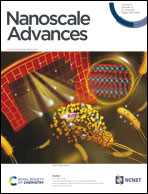Solvophobic-controlled synthesis of smart magneto-fluorescent nanostructures for real-time inspection of metallic fractures†
Abstract
The production of materials that contain more than one functional constituent, the so-called multifunctional materials, is quite relevant in advanced technology. By acting as building blocks, nanoparticles can be suitably explored for generating higher-order multifunctional structures. In this regard, herein, a special clustered magneto-fluorescent superstructure has been developed for non-destructive detection of flaws and shallow subsurface discontinuities in industrial ferromagnetic materials. The strategy consists of the solvophobic-controlled assembly of organic-based maghemite cores and water-based II–VI quantum dots, in the presence of hexadecyltrimethyl-ammonium bromide, CTAB, as a compatibilizer agent. This composite exhibited a high magnetic response (σmax = 66 emu g−1) and uniform size, in addition to tunable optical properties (QY = 78%). The strategy of utilizing nanoparticles as magneto-fluorescent nanoprobes to identify tiny slits represents a great advance, for improving the capability of precisely revealing the fracture boundary locations by visual real-time inspection. The nanoscale probes exhibit a low signal-to-noise ratio and a higher competitive performance in relation to the existing micrometric detection systems.



 Please wait while we load your content...
Please wait while we load your content...